Organizational Environment Analysis: Fonterra and McDonalds Report
VerifiedAdded on 2021/04/16
|12
|3058
|130
Report
AI Summary
This report provides a comprehensive analysis of the organizational environments of Fonterra and McDonalds, covering various aspects such as external and internal environmental factors, organizational culture, and structure. The report explores the technological, economic, and labor environments impacting Fonterra, along with its adaptive culture and strategies for managing livestock and promoting sustainability. It also examines the mechanistic and centralized organizational structure of McDonalds, discussing its hierarchical structure, span of control, and decision-making processes. Furthermore, the report delves into the sustainability initiatives of McDonalds and discusses ethical issues like bribery and CSR activities. The analysis compares and contrasts the two organizations, offering insights into their management practices and challenges.
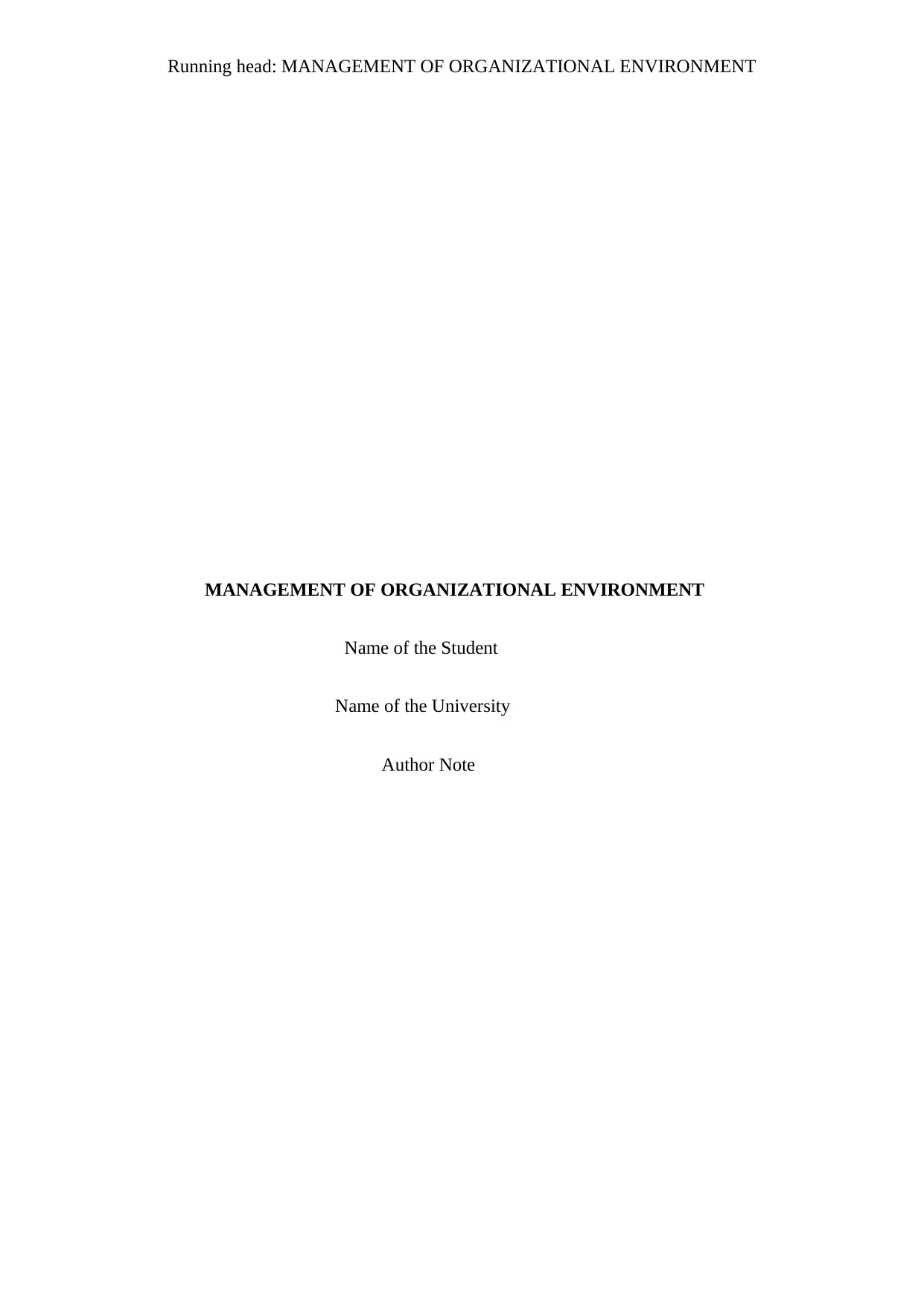
Running head: MANAGEMENT OF ORGANIZATIONAL ENVIRONMENT
MANAGEMENT OF ORGANIZATIONAL ENVIRONMENT
Name of the Student
Name of the University
Author Note
MANAGEMENT OF ORGANIZATIONAL ENVIRONMENT
Name of the Student
Name of the University
Author Note
Paraphrase This Document
Need a fresh take? Get an instant paraphrase of this document with our AI Paraphraser
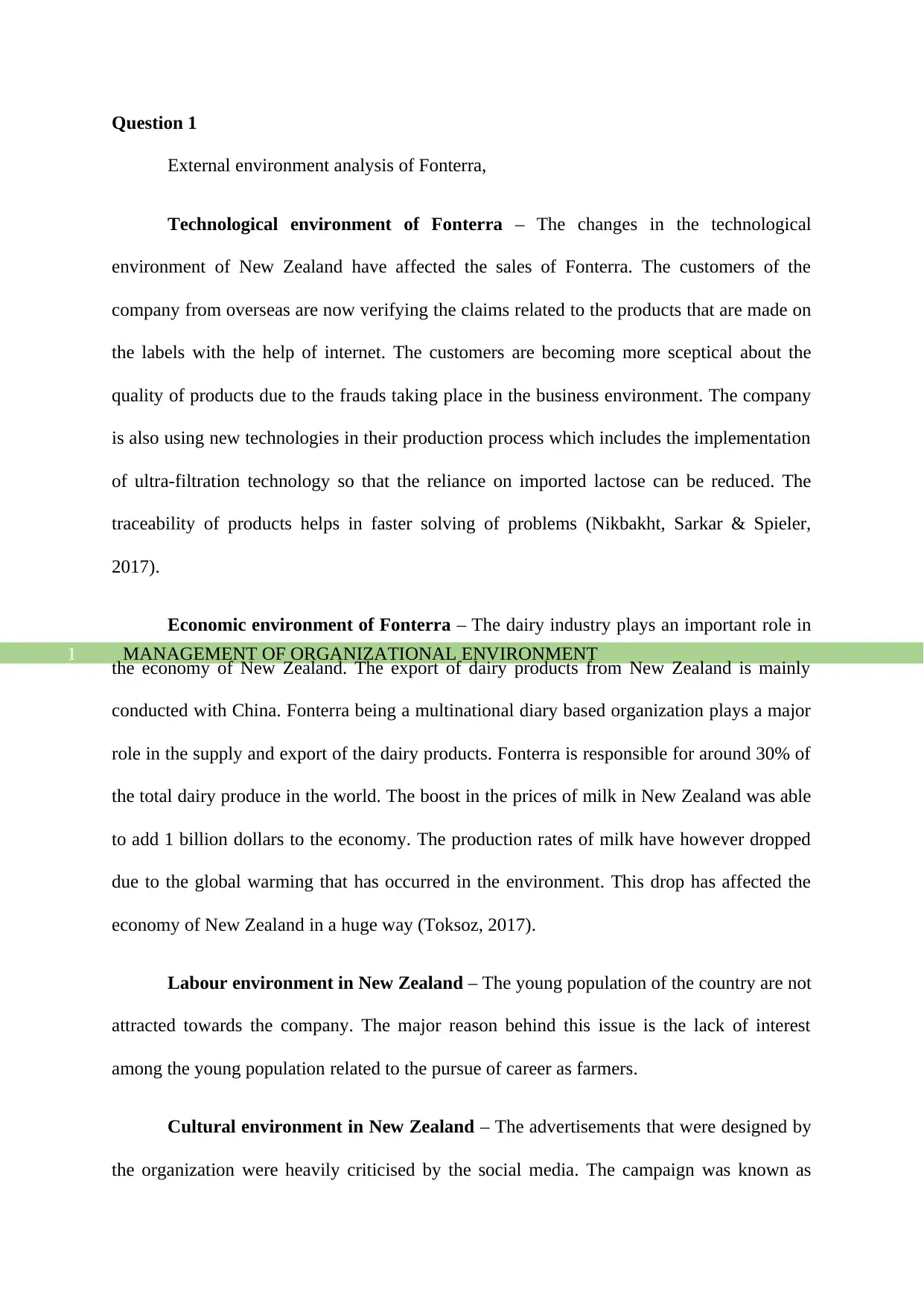
MANAGEMENT OF ORGANIZATIONAL ENVIRONMENT1
Question 1
External environment analysis of Fonterra,
Technological environment of Fonterra – The changes in the technological
environment of New Zealand have affected the sales of Fonterra. The customers of the
company from overseas are now verifying the claims related to the products that are made on
the labels with the help of internet. The customers are becoming more sceptical about the
quality of products due to the frauds taking place in the business environment. The company
is also using new technologies in their production process which includes the implementation
of ultra-filtration technology so that the reliance on imported lactose can be reduced. The
traceability of products helps in faster solving of problems (Nikbakht, Sarkar & Spieler,
2017).
Economic environment of Fonterra – The dairy industry plays an important role in
the economy of New Zealand. The export of dairy products from New Zealand is mainly
conducted with China. Fonterra being a multinational diary based organization plays a major
role in the supply and export of the dairy products. Fonterra is responsible for around 30% of
the total dairy produce in the world. The boost in the prices of milk in New Zealand was able
to add 1 billion dollars to the economy. The production rates of milk have however dropped
due to the global warming that has occurred in the environment. This drop has affected the
economy of New Zealand in a huge way (Toksoz, 2017).
Labour environment in New Zealand – The young population of the country are not
attracted towards the company. The major reason behind this issue is the lack of interest
among the young population related to the pursue of career as farmers.
Cultural environment in New Zealand – The advertisements that were designed by
the organization were heavily criticised by the social media. The campaign was known as
Question 1
External environment analysis of Fonterra,
Technological environment of Fonterra – The changes in the technological
environment of New Zealand have affected the sales of Fonterra. The customers of the
company from overseas are now verifying the claims related to the products that are made on
the labels with the help of internet. The customers are becoming more sceptical about the
quality of products due to the frauds taking place in the business environment. The company
is also using new technologies in their production process which includes the implementation
of ultra-filtration technology so that the reliance on imported lactose can be reduced. The
traceability of products helps in faster solving of problems (Nikbakht, Sarkar & Spieler,
2017).
Economic environment of Fonterra – The dairy industry plays an important role in
the economy of New Zealand. The export of dairy products from New Zealand is mainly
conducted with China. Fonterra being a multinational diary based organization plays a major
role in the supply and export of the dairy products. Fonterra is responsible for around 30% of
the total dairy produce in the world. The boost in the prices of milk in New Zealand was able
to add 1 billion dollars to the economy. The production rates of milk have however dropped
due to the global warming that has occurred in the environment. This drop has affected the
economy of New Zealand in a huge way (Toksoz, 2017).
Labour environment in New Zealand – The young population of the country are not
attracted towards the company. The major reason behind this issue is the lack of interest
among the young population related to the pursue of career as farmers.
Cultural environment in New Zealand – The advertisements that were designed by
the organization were heavily criticised by the social media. The campaign was known as
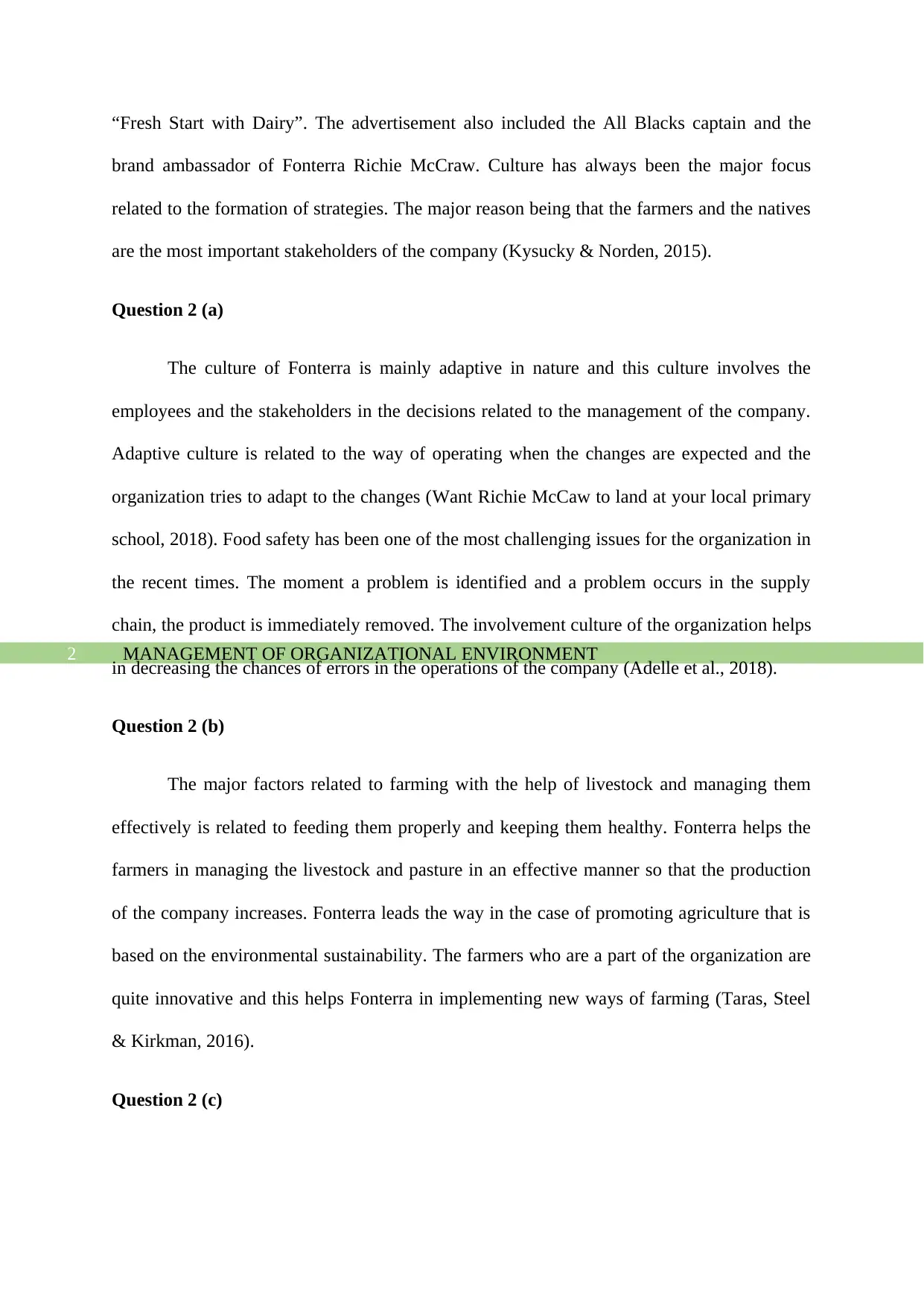
MANAGEMENT OF ORGANIZATIONAL ENVIRONMENT2
“Fresh Start with Dairy”. The advertisement also included the All Blacks captain and the
brand ambassador of Fonterra Richie McCraw. Culture has always been the major focus
related to the formation of strategies. The major reason being that the farmers and the natives
are the most important stakeholders of the company (Kysucky & Norden, 2015).
Question 2 (a)
The culture of Fonterra is mainly adaptive in nature and this culture involves the
employees and the stakeholders in the decisions related to the management of the company.
Adaptive culture is related to the way of operating when the changes are expected and the
organization tries to adapt to the changes (Want Richie McCaw to land at your local primary
school, 2018). Food safety has been one of the most challenging issues for the organization in
the recent times. The moment a problem is identified and a problem occurs in the supply
chain, the product is immediately removed. The involvement culture of the organization helps
in decreasing the chances of errors in the operations of the company (Adelle et al., 2018).
Question 2 (b)
The major factors related to farming with the help of livestock and managing them
effectively is related to feeding them properly and keeping them healthy. Fonterra helps the
farmers in managing the livestock and pasture in an effective manner so that the production
of the company increases. Fonterra leads the way in the case of promoting agriculture that is
based on the environmental sustainability. The farmers who are a part of the organization are
quite innovative and this helps Fonterra in implementing new ways of farming (Taras, Steel
& Kirkman, 2016).
Question 2 (c)
“Fresh Start with Dairy”. The advertisement also included the All Blacks captain and the
brand ambassador of Fonterra Richie McCraw. Culture has always been the major focus
related to the formation of strategies. The major reason being that the farmers and the natives
are the most important stakeholders of the company (Kysucky & Norden, 2015).
Question 2 (a)
The culture of Fonterra is mainly adaptive in nature and this culture involves the
employees and the stakeholders in the decisions related to the management of the company.
Adaptive culture is related to the way of operating when the changes are expected and the
organization tries to adapt to the changes (Want Richie McCaw to land at your local primary
school, 2018). Food safety has been one of the most challenging issues for the organization in
the recent times. The moment a problem is identified and a problem occurs in the supply
chain, the product is immediately removed. The involvement culture of the organization helps
in decreasing the chances of errors in the operations of the company (Adelle et al., 2018).
Question 2 (b)
The major factors related to farming with the help of livestock and managing them
effectively is related to feeding them properly and keeping them healthy. Fonterra helps the
farmers in managing the livestock and pasture in an effective manner so that the production
of the company increases. Fonterra leads the way in the case of promoting agriculture that is
based on the environmental sustainability. The farmers who are a part of the organization are
quite innovative and this helps Fonterra in implementing new ways of farming (Taras, Steel
& Kirkman, 2016).
Question 2 (c)
⊘ This is a preview!⊘
Do you want full access?
Subscribe today to unlock all pages.

Trusted by 1+ million students worldwide
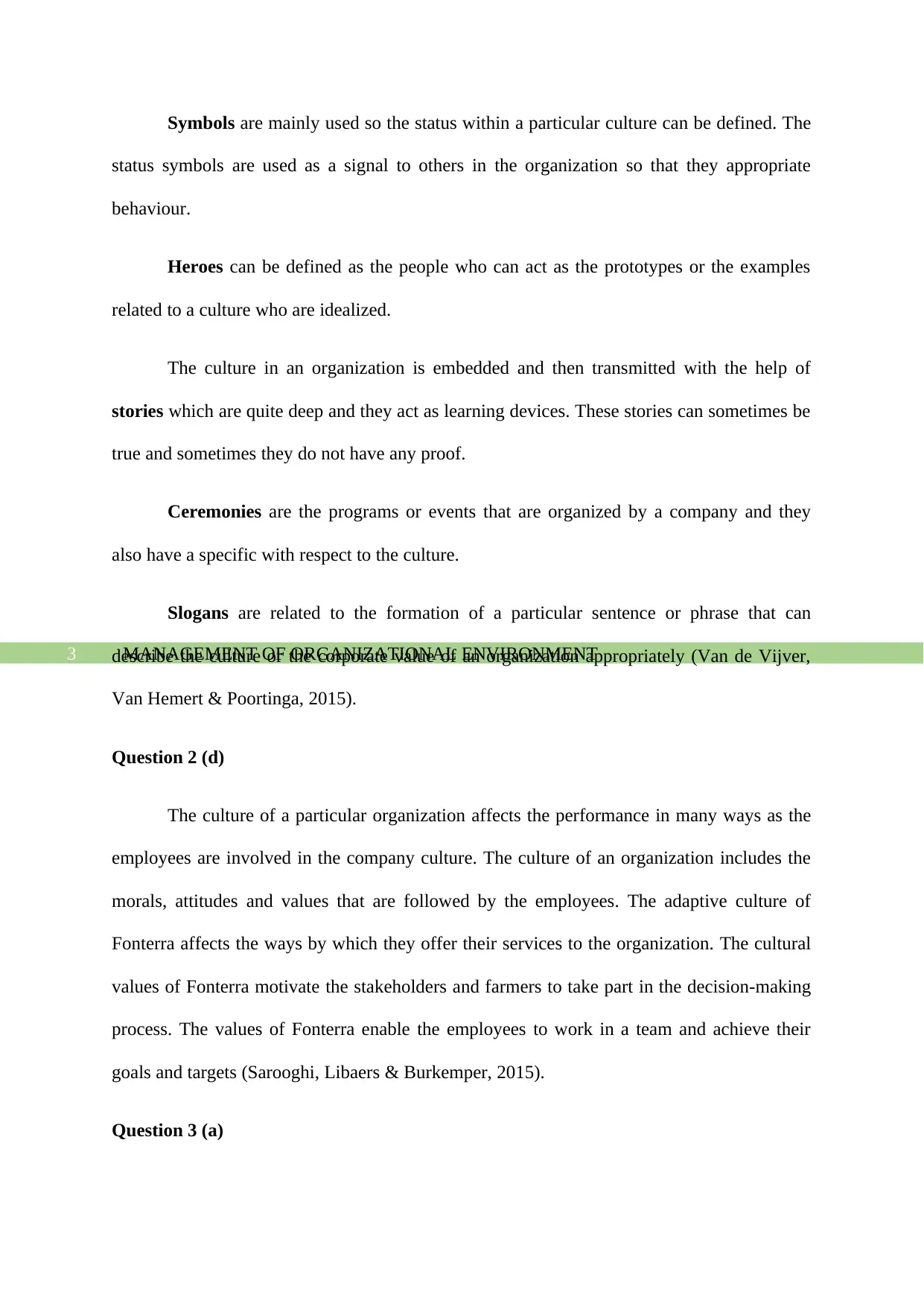
MANAGEMENT OF ORGANIZATIONAL ENVIRONMENT3
Symbols are mainly used so the status within a particular culture can be defined. The
status symbols are used as a signal to others in the organization so that they appropriate
behaviour.
Heroes can be defined as the people who can act as the prototypes or the examples
related to a culture who are idealized.
The culture in an organization is embedded and then transmitted with the help of
stories which are quite deep and they act as learning devices. These stories can sometimes be
true and sometimes they do not have any proof.
Ceremonies are the programs or events that are organized by a company and they
also have a specific with respect to the culture.
Slogans are related to the formation of a particular sentence or phrase that can
describe the culture or the corporate value of an organization appropriately (Van de Vijver,
Van Hemert & Poortinga, 2015).
Question 2 (d)
The culture of a particular organization affects the performance in many ways as the
employees are involved in the company culture. The culture of an organization includes the
morals, attitudes and values that are followed by the employees. The adaptive culture of
Fonterra affects the ways by which they offer their services to the organization. The cultural
values of Fonterra motivate the stakeholders and farmers to take part in the decision-making
process. The values of Fonterra enable the employees to work in a team and achieve their
goals and targets (Sarooghi, Libaers & Burkemper, 2015).
Question 3 (a)
Symbols are mainly used so the status within a particular culture can be defined. The
status symbols are used as a signal to others in the organization so that they appropriate
behaviour.
Heroes can be defined as the people who can act as the prototypes or the examples
related to a culture who are idealized.
The culture in an organization is embedded and then transmitted with the help of
stories which are quite deep and they act as learning devices. These stories can sometimes be
true and sometimes they do not have any proof.
Ceremonies are the programs or events that are organized by a company and they
also have a specific with respect to the culture.
Slogans are related to the formation of a particular sentence or phrase that can
describe the culture or the corporate value of an organization appropriately (Van de Vijver,
Van Hemert & Poortinga, 2015).
Question 2 (d)
The culture of a particular organization affects the performance in many ways as the
employees are involved in the company culture. The culture of an organization includes the
morals, attitudes and values that are followed by the employees. The adaptive culture of
Fonterra affects the ways by which they offer their services to the organization. The cultural
values of Fonterra motivate the stakeholders and farmers to take part in the decision-making
process. The values of Fonterra enable the employees to work in a team and achieve their
goals and targets (Sarooghi, Libaers & Burkemper, 2015).
Question 3 (a)
Paraphrase This Document
Need a fresh take? Get an instant paraphrase of this document with our AI Paraphraser
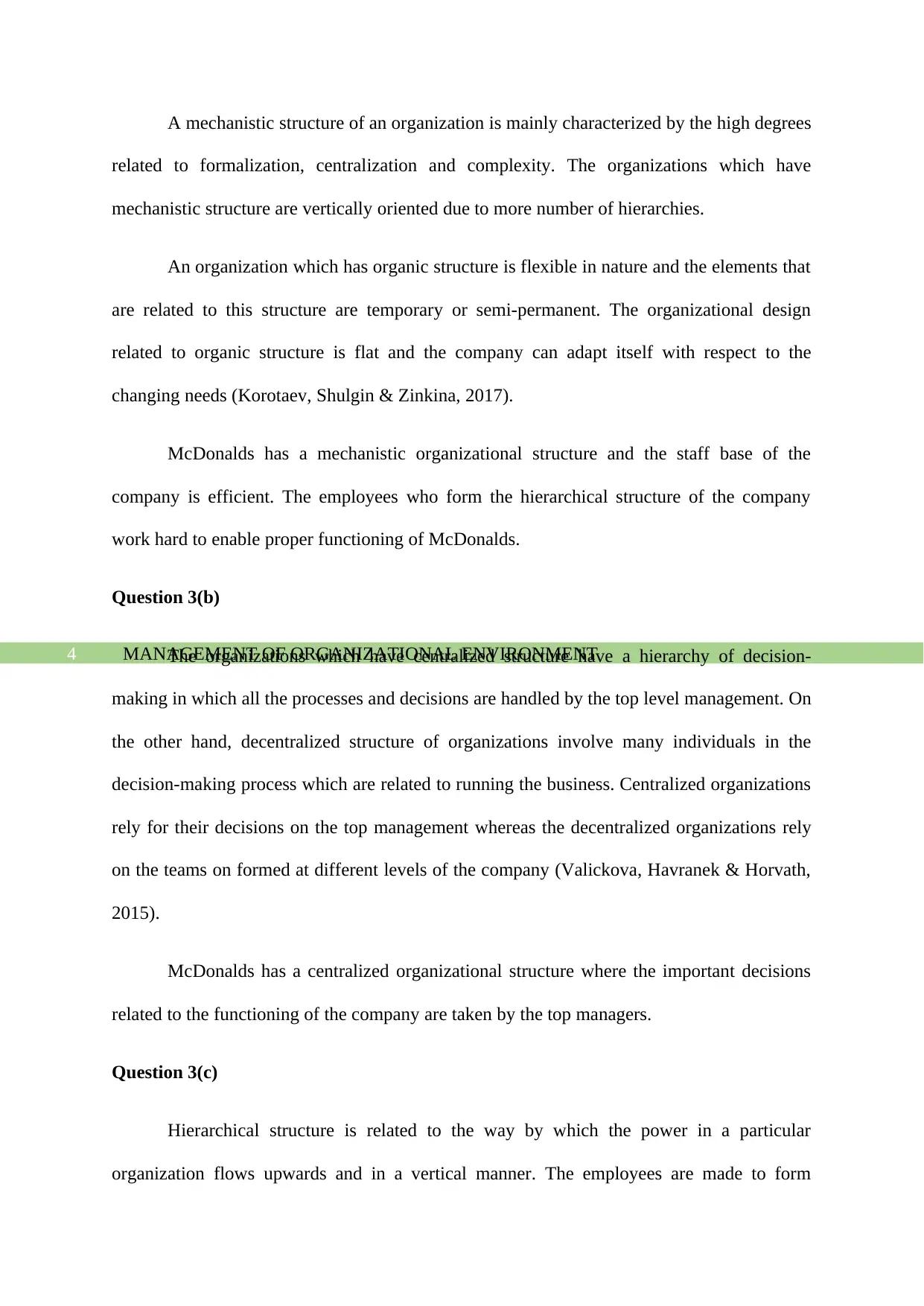
MANAGEMENT OF ORGANIZATIONAL ENVIRONMENT4
A mechanistic structure of an organization is mainly characterized by the high degrees
related to formalization, centralization and complexity. The organizations which have
mechanistic structure are vertically oriented due to more number of hierarchies.
An organization which has organic structure is flexible in nature and the elements that
are related to this structure are temporary or semi-permanent. The organizational design
related to organic structure is flat and the company can adapt itself with respect to the
changing needs (Korotaev, Shulgin & Zinkina, 2017).
McDonalds has a mechanistic organizational structure and the staff base of the
company is efficient. The employees who form the hierarchical structure of the company
work hard to enable proper functioning of McDonalds.
Question 3(b)
The organizations which have centralized structure have a hierarchy of decision-
making in which all the processes and decisions are handled by the top level management. On
the other hand, decentralized structure of organizations involve many individuals in the
decision-making process which are related to running the business. Centralized organizations
rely for their decisions on the top management whereas the decentralized organizations rely
on the teams on formed at different levels of the company (Valickova, Havranek & Horvath,
2015).
McDonalds has a centralized organizational structure where the important decisions
related to the functioning of the company are taken by the top managers.
Question 3(c)
Hierarchical structure is related to the way by which the power in a particular
organization flows upwards and in a vertical manner. The employees are made to form
A mechanistic structure of an organization is mainly characterized by the high degrees
related to formalization, centralization and complexity. The organizations which have
mechanistic structure are vertically oriented due to more number of hierarchies.
An organization which has organic structure is flexible in nature and the elements that
are related to this structure are temporary or semi-permanent. The organizational design
related to organic structure is flat and the company can adapt itself with respect to the
changing needs (Korotaev, Shulgin & Zinkina, 2017).
McDonalds has a mechanistic organizational structure and the staff base of the
company is efficient. The employees who form the hierarchical structure of the company
work hard to enable proper functioning of McDonalds.
Question 3(b)
The organizations which have centralized structure have a hierarchy of decision-
making in which all the processes and decisions are handled by the top level management. On
the other hand, decentralized structure of organizations involve many individuals in the
decision-making process which are related to running the business. Centralized organizations
rely for their decisions on the top management whereas the decentralized organizations rely
on the teams on formed at different levels of the company (Valickova, Havranek & Horvath,
2015).
McDonalds has a centralized organizational structure where the important decisions
related to the functioning of the company are taken by the top managers.
Question 3(c)
Hierarchical structure is related to the way by which the power in a particular
organization flows upwards and in a vertical manner. The employees are made to form
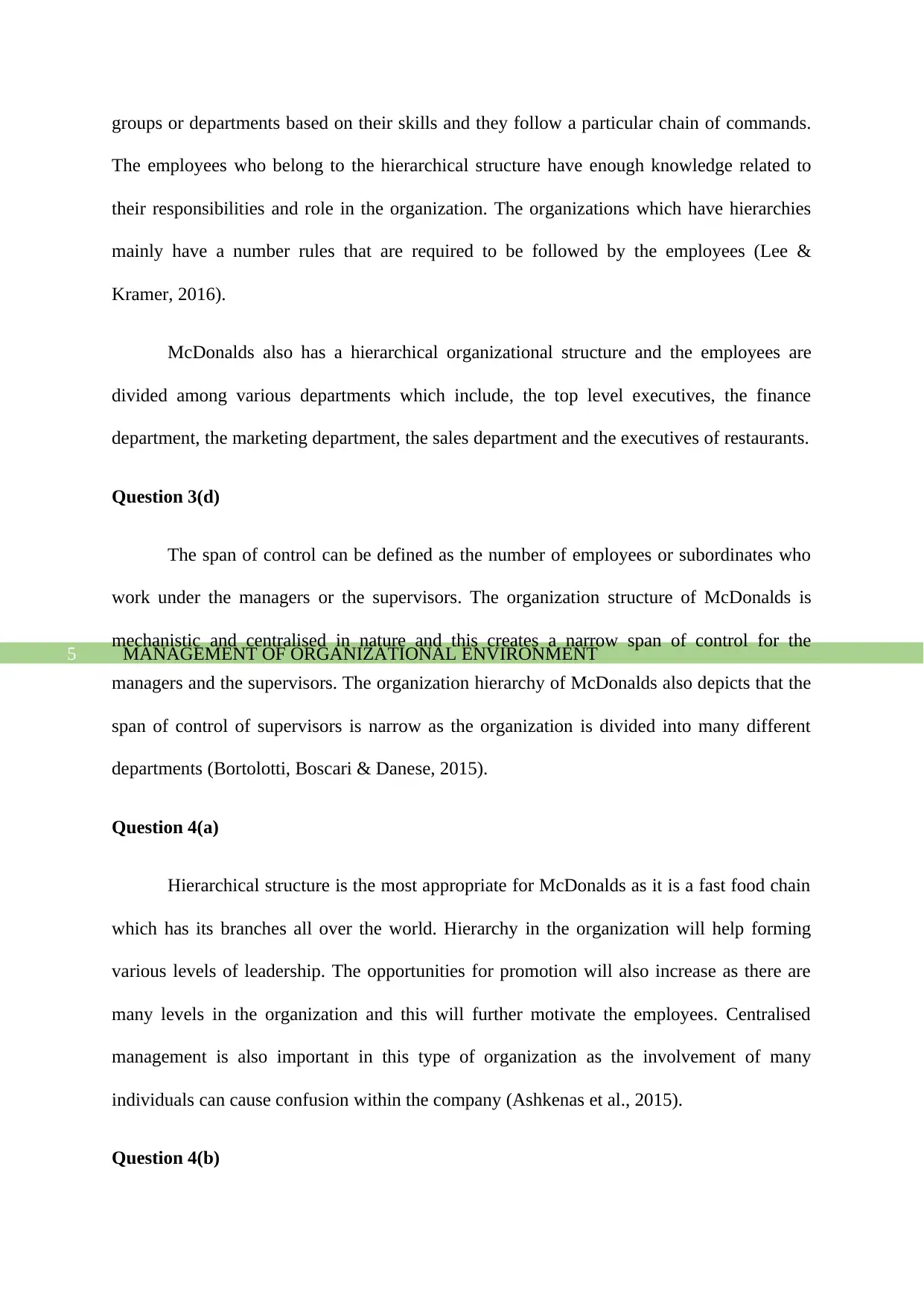
MANAGEMENT OF ORGANIZATIONAL ENVIRONMENT5
groups or departments based on their skills and they follow a particular chain of commands.
The employees who belong to the hierarchical structure have enough knowledge related to
their responsibilities and role in the organization. The organizations which have hierarchies
mainly have a number rules that are required to be followed by the employees (Lee &
Kramer, 2016).
McDonalds also has a hierarchical organizational structure and the employees are
divided among various departments which include, the top level executives, the finance
department, the marketing department, the sales department and the executives of restaurants.
Question 3(d)
The span of control can be defined as the number of employees or subordinates who
work under the managers or the supervisors. The organization structure of McDonalds is
mechanistic and centralised in nature and this creates a narrow span of control for the
managers and the supervisors. The organization hierarchy of McDonalds also depicts that the
span of control of supervisors is narrow as the organization is divided into many different
departments (Bortolotti, Boscari & Danese, 2015).
Question 4(a)
Hierarchical structure is the most appropriate for McDonalds as it is a fast food chain
which has its branches all over the world. Hierarchy in the organization will help forming
various levels of leadership. The opportunities for promotion will also increase as there are
many levels in the organization and this will further motivate the employees. Centralised
management is also important in this type of organization as the involvement of many
individuals can cause confusion within the company (Ashkenas et al., 2015).
Question 4(b)
groups or departments based on their skills and they follow a particular chain of commands.
The employees who belong to the hierarchical structure have enough knowledge related to
their responsibilities and role in the organization. The organizations which have hierarchies
mainly have a number rules that are required to be followed by the employees (Lee &
Kramer, 2016).
McDonalds also has a hierarchical organizational structure and the employees are
divided among various departments which include, the top level executives, the finance
department, the marketing department, the sales department and the executives of restaurants.
Question 3(d)
The span of control can be defined as the number of employees or subordinates who
work under the managers or the supervisors. The organization structure of McDonalds is
mechanistic and centralised in nature and this creates a narrow span of control for the
managers and the supervisors. The organization hierarchy of McDonalds also depicts that the
span of control of supervisors is narrow as the organization is divided into many different
departments (Bortolotti, Boscari & Danese, 2015).
Question 4(a)
Hierarchical structure is the most appropriate for McDonalds as it is a fast food chain
which has its branches all over the world. Hierarchy in the organization will help forming
various levels of leadership. The opportunities for promotion will also increase as there are
many levels in the organization and this will further motivate the employees. Centralised
management is also important in this type of organization as the involvement of many
individuals can cause confusion within the company (Ashkenas et al., 2015).
Question 4(b)
⊘ This is a preview!⊘
Do you want full access?
Subscribe today to unlock all pages.

Trusted by 1+ million students worldwide
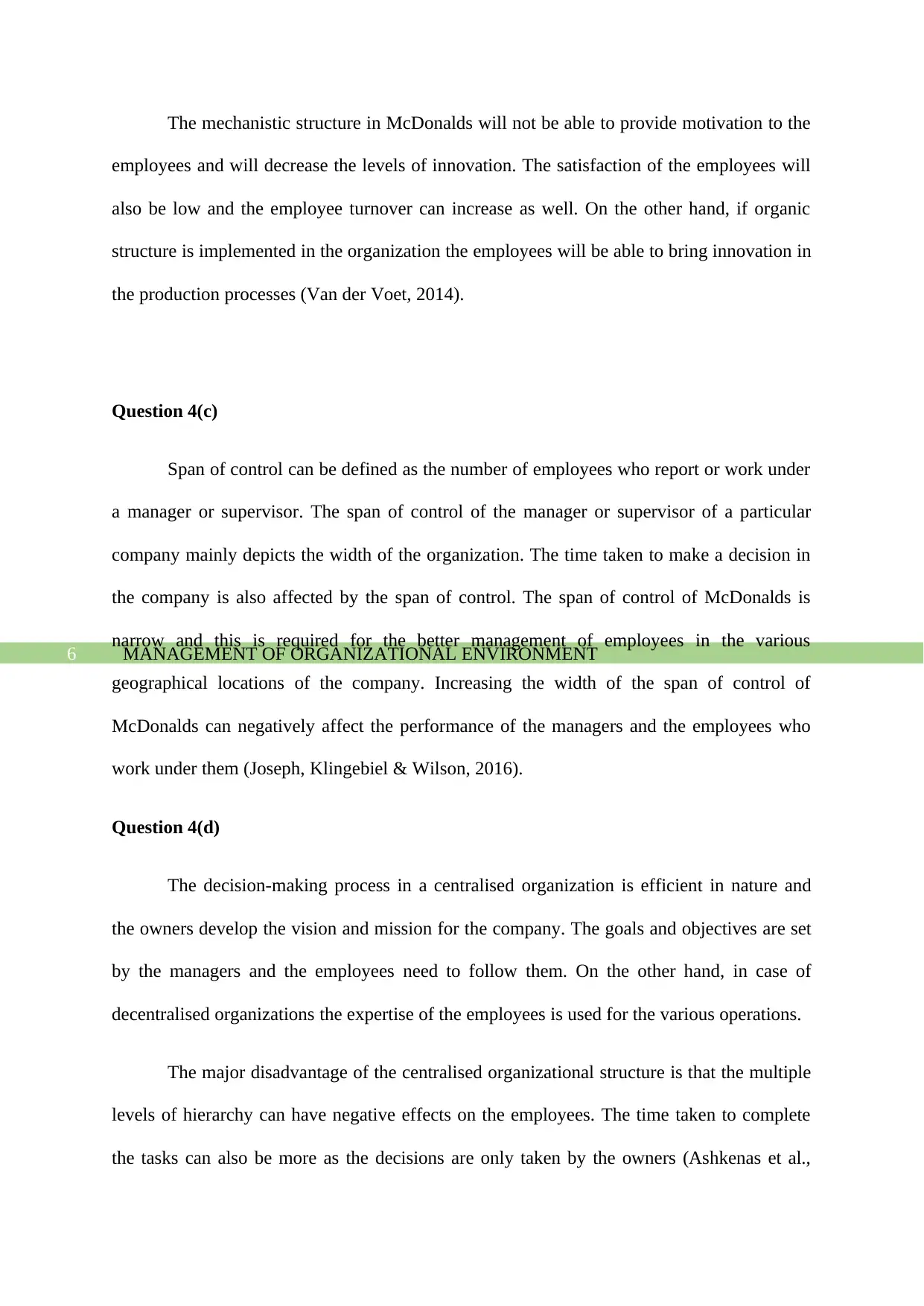
MANAGEMENT OF ORGANIZATIONAL ENVIRONMENT6
The mechanistic structure in McDonalds will not be able to provide motivation to the
employees and will decrease the levels of innovation. The satisfaction of the employees will
also be low and the employee turnover can increase as well. On the other hand, if organic
structure is implemented in the organization the employees will be able to bring innovation in
the production processes (Van der Voet, 2014).
Question 4(c)
Span of control can be defined as the number of employees who report or work under
a manager or supervisor. The span of control of the manager or supervisor of a particular
company mainly depicts the width of the organization. The time taken to make a decision in
the company is also affected by the span of control. The span of control of McDonalds is
narrow and this is required for the better management of employees in the various
geographical locations of the company. Increasing the width of the span of control of
McDonalds can negatively affect the performance of the managers and the employees who
work under them (Joseph, Klingebiel & Wilson, 2016).
Question 4(d)
The decision-making process in a centralised organization is efficient in nature and
the owners develop the vision and mission for the company. The goals and objectives are set
by the managers and the employees need to follow them. On the other hand, in case of
decentralised organizations the expertise of the employees is used for the various operations.
The major disadvantage of the centralised organizational structure is that the multiple
levels of hierarchy can have negative effects on the employees. The time taken to complete
the tasks can also be more as the decisions are only taken by the owners (Ashkenas et al.,
The mechanistic structure in McDonalds will not be able to provide motivation to the
employees and will decrease the levels of innovation. The satisfaction of the employees will
also be low and the employee turnover can increase as well. On the other hand, if organic
structure is implemented in the organization the employees will be able to bring innovation in
the production processes (Van der Voet, 2014).
Question 4(c)
Span of control can be defined as the number of employees who report or work under
a manager or supervisor. The span of control of the manager or supervisor of a particular
company mainly depicts the width of the organization. The time taken to make a decision in
the company is also affected by the span of control. The span of control of McDonalds is
narrow and this is required for the better management of employees in the various
geographical locations of the company. Increasing the width of the span of control of
McDonalds can negatively affect the performance of the managers and the employees who
work under them (Joseph, Klingebiel & Wilson, 2016).
Question 4(d)
The decision-making process in a centralised organization is efficient in nature and
the owners develop the vision and mission for the company. The goals and objectives are set
by the managers and the employees need to follow them. On the other hand, in case of
decentralised organizations the expertise of the employees is used for the various operations.
The major disadvantage of the centralised organizational structure is that the multiple
levels of hierarchy can have negative effects on the employees. The time taken to complete
the tasks can also be more as the decisions are only taken by the owners (Ashkenas et al.,
Paraphrase This Document
Need a fresh take? Get an instant paraphrase of this document with our AI Paraphraser
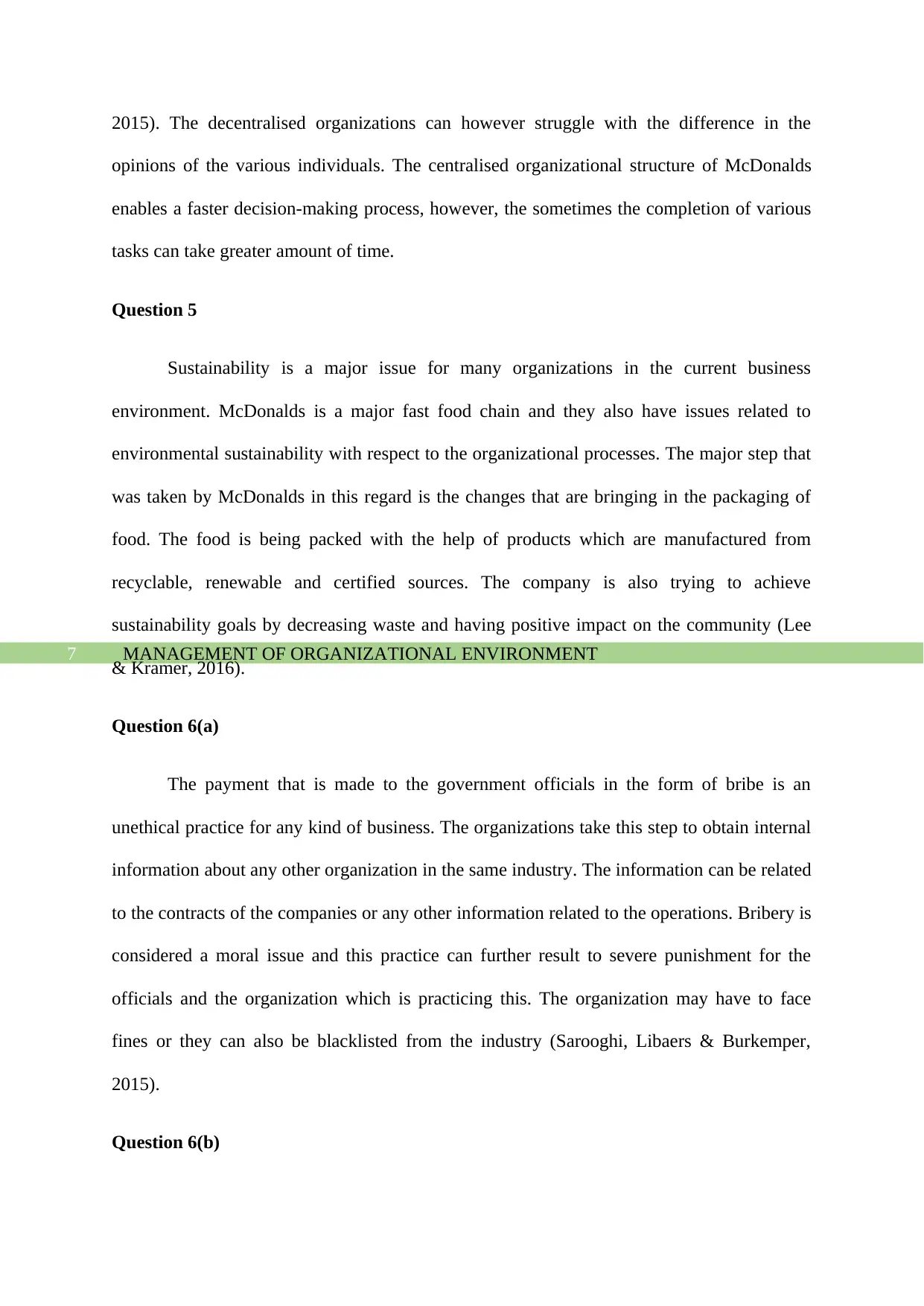
MANAGEMENT OF ORGANIZATIONAL ENVIRONMENT7
2015). The decentralised organizations can however struggle with the difference in the
opinions of the various individuals. The centralised organizational structure of McDonalds
enables a faster decision-making process, however, the sometimes the completion of various
tasks can take greater amount of time.
Question 5
Sustainability is a major issue for many organizations in the current business
environment. McDonalds is a major fast food chain and they also have issues related to
environmental sustainability with respect to the organizational processes. The major step that
was taken by McDonalds in this regard is the changes that are bringing in the packaging of
food. The food is being packed with the help of products which are manufactured from
recyclable, renewable and certified sources. The company is also trying to achieve
sustainability goals by decreasing waste and having positive impact on the community (Lee
& Kramer, 2016).
Question 6(a)
The payment that is made to the government officials in the form of bribe is an
unethical practice for any kind of business. The organizations take this step to obtain internal
information about any other organization in the same industry. The information can be related
to the contracts of the companies or any other information related to the operations. Bribery is
considered a moral issue and this practice can further result to severe punishment for the
officials and the organization which is practicing this. The organization may have to face
fines or they can also be blacklisted from the industry (Sarooghi, Libaers & Burkemper,
2015).
Question 6(b)
2015). The decentralised organizations can however struggle with the difference in the
opinions of the various individuals. The centralised organizational structure of McDonalds
enables a faster decision-making process, however, the sometimes the completion of various
tasks can take greater amount of time.
Question 5
Sustainability is a major issue for many organizations in the current business
environment. McDonalds is a major fast food chain and they also have issues related to
environmental sustainability with respect to the organizational processes. The major step that
was taken by McDonalds in this regard is the changes that are bringing in the packaging of
food. The food is being packed with the help of products which are manufactured from
recyclable, renewable and certified sources. The company is also trying to achieve
sustainability goals by decreasing waste and having positive impact on the community (Lee
& Kramer, 2016).
Question 6(a)
The payment that is made to the government officials in the form of bribe is an
unethical practice for any kind of business. The organizations take this step to obtain internal
information about any other organization in the same industry. The information can be related
to the contracts of the companies or any other information related to the operations. Bribery is
considered a moral issue and this practice can further result to severe punishment for the
officials and the organization which is practicing this. The organization may have to face
fines or they can also be blacklisted from the industry (Sarooghi, Libaers & Burkemper,
2015).
Question 6(b)
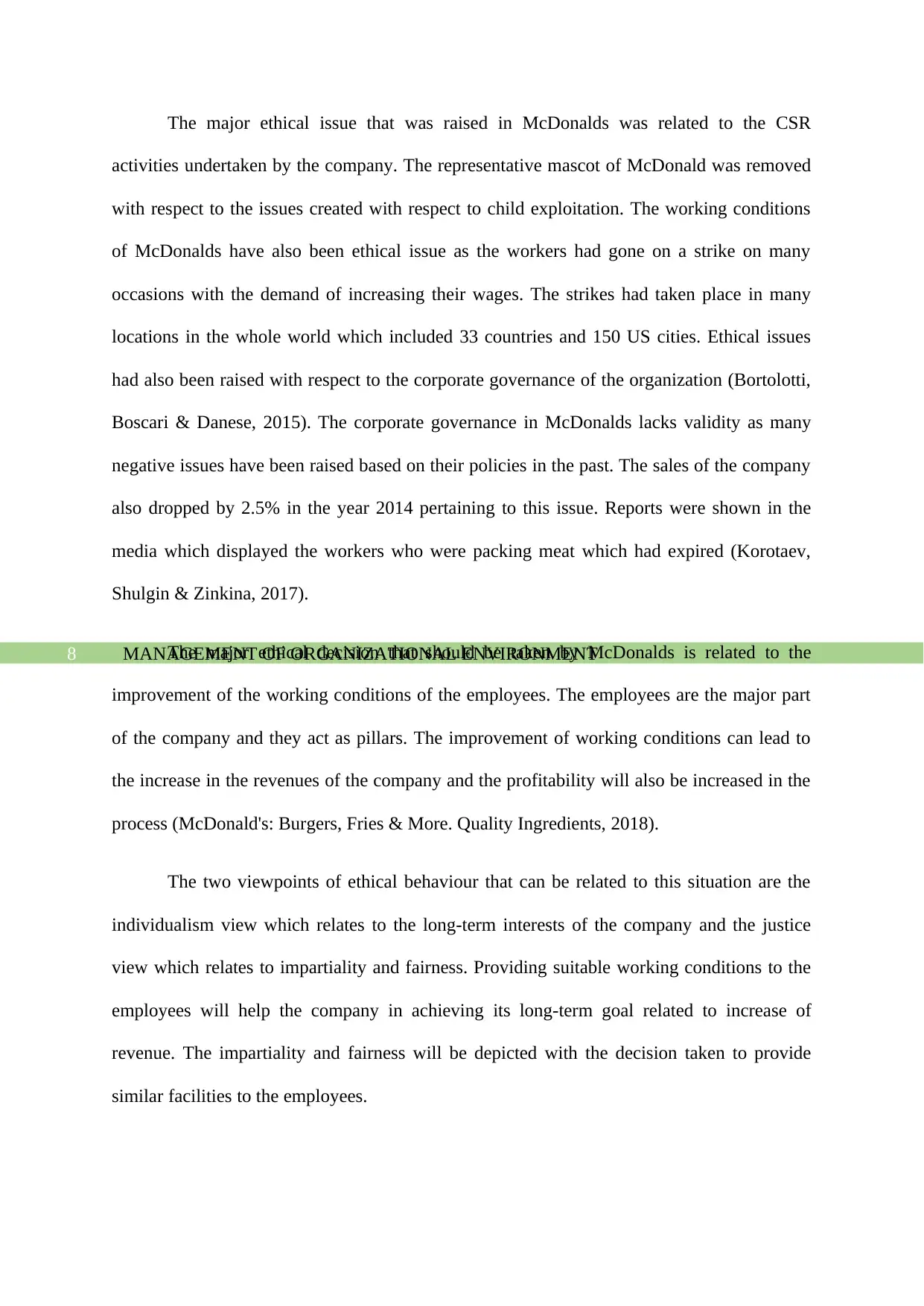
MANAGEMENT OF ORGANIZATIONAL ENVIRONMENT8
The major ethical issue that was raised in McDonalds was related to the CSR
activities undertaken by the company. The representative mascot of McDonald was removed
with respect to the issues created with respect to child exploitation. The working conditions
of McDonalds have also been ethical issue as the workers had gone on a strike on many
occasions with the demand of increasing their wages. The strikes had taken place in many
locations in the whole world which included 33 countries and 150 US cities. Ethical issues
had also been raised with respect to the corporate governance of the organization (Bortolotti,
Boscari & Danese, 2015). The corporate governance in McDonalds lacks validity as many
negative issues have been raised based on their policies in the past. The sales of the company
also dropped by 2.5% in the year 2014 pertaining to this issue. Reports were shown in the
media which displayed the workers who were packing meat which had expired (Korotaev,
Shulgin & Zinkina, 2017).
The major ethical decision that should be taken by McDonalds is related to the
improvement of the working conditions of the employees. The employees are the major part
of the company and they act as pillars. The improvement of working conditions can lead to
the increase in the revenues of the company and the profitability will also be increased in the
process (McDonald's: Burgers, Fries & More. Quality Ingredients, 2018).
The two viewpoints of ethical behaviour that can be related to this situation are the
individualism view which relates to the long-term interests of the company and the justice
view which relates to impartiality and fairness. Providing suitable working conditions to the
employees will help the company in achieving its long-term goal related to increase of
revenue. The impartiality and fairness will be depicted with the decision taken to provide
similar facilities to the employees.
The major ethical issue that was raised in McDonalds was related to the CSR
activities undertaken by the company. The representative mascot of McDonald was removed
with respect to the issues created with respect to child exploitation. The working conditions
of McDonalds have also been ethical issue as the workers had gone on a strike on many
occasions with the demand of increasing their wages. The strikes had taken place in many
locations in the whole world which included 33 countries and 150 US cities. Ethical issues
had also been raised with respect to the corporate governance of the organization (Bortolotti,
Boscari & Danese, 2015). The corporate governance in McDonalds lacks validity as many
negative issues have been raised based on their policies in the past. The sales of the company
also dropped by 2.5% in the year 2014 pertaining to this issue. Reports were shown in the
media which displayed the workers who were packing meat which had expired (Korotaev,
Shulgin & Zinkina, 2017).
The major ethical decision that should be taken by McDonalds is related to the
improvement of the working conditions of the employees. The employees are the major part
of the company and they act as pillars. The improvement of working conditions can lead to
the increase in the revenues of the company and the profitability will also be increased in the
process (McDonald's: Burgers, Fries & More. Quality Ingredients, 2018).
The two viewpoints of ethical behaviour that can be related to this situation are the
individualism view which relates to the long-term interests of the company and the justice
view which relates to impartiality and fairness. Providing suitable working conditions to the
employees will help the company in achieving its long-term goal related to increase of
revenue. The impartiality and fairness will be depicted with the decision taken to provide
similar facilities to the employees.
⊘ This is a preview!⊘
Do you want full access?
Subscribe today to unlock all pages.

Trusted by 1+ million students worldwide
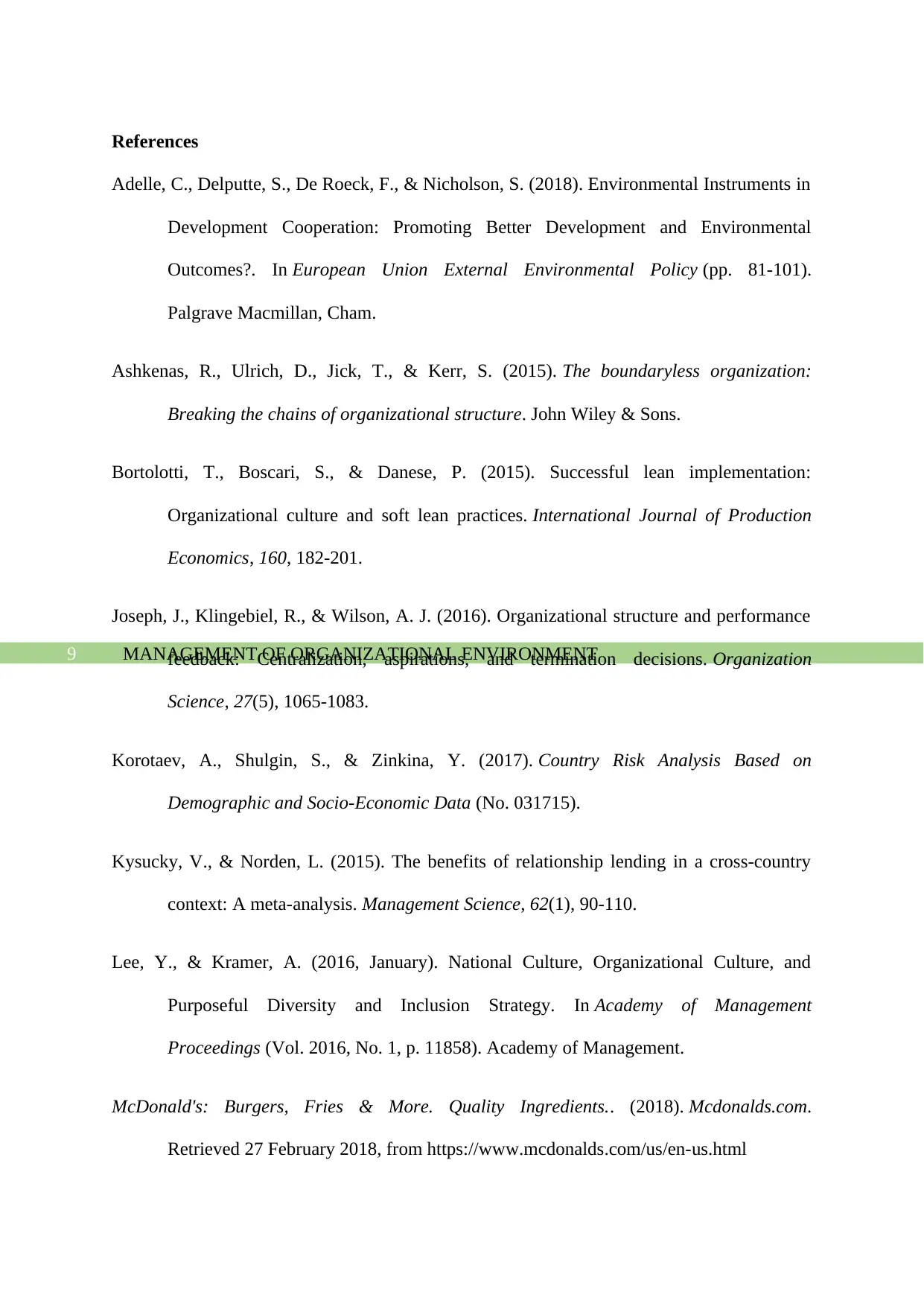
MANAGEMENT OF ORGANIZATIONAL ENVIRONMENT9
References
Adelle, C., Delputte, S., De Roeck, F., & Nicholson, S. (2018). Environmental Instruments in
Development Cooperation: Promoting Better Development and Environmental
Outcomes?. In European Union External Environmental Policy (pp. 81-101).
Palgrave Macmillan, Cham.
Ashkenas, R., Ulrich, D., Jick, T., & Kerr, S. (2015). The boundaryless organization:
Breaking the chains of organizational structure. John Wiley & Sons.
Bortolotti, T., Boscari, S., & Danese, P. (2015). Successful lean implementation:
Organizational culture and soft lean practices. International Journal of Production
Economics, 160, 182-201.
Joseph, J., Klingebiel, R., & Wilson, A. J. (2016). Organizational structure and performance
feedback: Centralization, aspirations, and termination decisions. Organization
Science, 27(5), 1065-1083.
Korotaev, A., Shulgin, S., & Zinkina, Y. (2017). Country Risk Analysis Based on
Demographic and Socio-Economic Data (No. 031715).
Kysucky, V., & Norden, L. (2015). The benefits of relationship lending in a cross-country
context: A meta-analysis. Management Science, 62(1), 90-110.
Lee, Y., & Kramer, A. (2016, January). National Culture, Organizational Culture, and
Purposeful Diversity and Inclusion Strategy. In Academy of Management
Proceedings (Vol. 2016, No. 1, p. 11858). Academy of Management.
McDonald's: Burgers, Fries & More. Quality Ingredients.. (2018). Mcdonalds.com.
Retrieved 27 February 2018, from https://www.mcdonalds.com/us/en-us.html
References
Adelle, C., Delputte, S., De Roeck, F., & Nicholson, S. (2018). Environmental Instruments in
Development Cooperation: Promoting Better Development and Environmental
Outcomes?. In European Union External Environmental Policy (pp. 81-101).
Palgrave Macmillan, Cham.
Ashkenas, R., Ulrich, D., Jick, T., & Kerr, S. (2015). The boundaryless organization:
Breaking the chains of organizational structure. John Wiley & Sons.
Bortolotti, T., Boscari, S., & Danese, P. (2015). Successful lean implementation:
Organizational culture and soft lean practices. International Journal of Production
Economics, 160, 182-201.
Joseph, J., Klingebiel, R., & Wilson, A. J. (2016). Organizational structure and performance
feedback: Centralization, aspirations, and termination decisions. Organization
Science, 27(5), 1065-1083.
Korotaev, A., Shulgin, S., & Zinkina, Y. (2017). Country Risk Analysis Based on
Demographic and Socio-Economic Data (No. 031715).
Kysucky, V., & Norden, L. (2015). The benefits of relationship lending in a cross-country
context: A meta-analysis. Management Science, 62(1), 90-110.
Lee, Y., & Kramer, A. (2016, January). National Culture, Organizational Culture, and
Purposeful Diversity and Inclusion Strategy. In Academy of Management
Proceedings (Vol. 2016, No. 1, p. 11858). Academy of Management.
McDonald's: Burgers, Fries & More. Quality Ingredients.. (2018). Mcdonalds.com.
Retrieved 27 February 2018, from https://www.mcdonalds.com/us/en-us.html
Paraphrase This Document
Need a fresh take? Get an instant paraphrase of this document with our AI Paraphraser
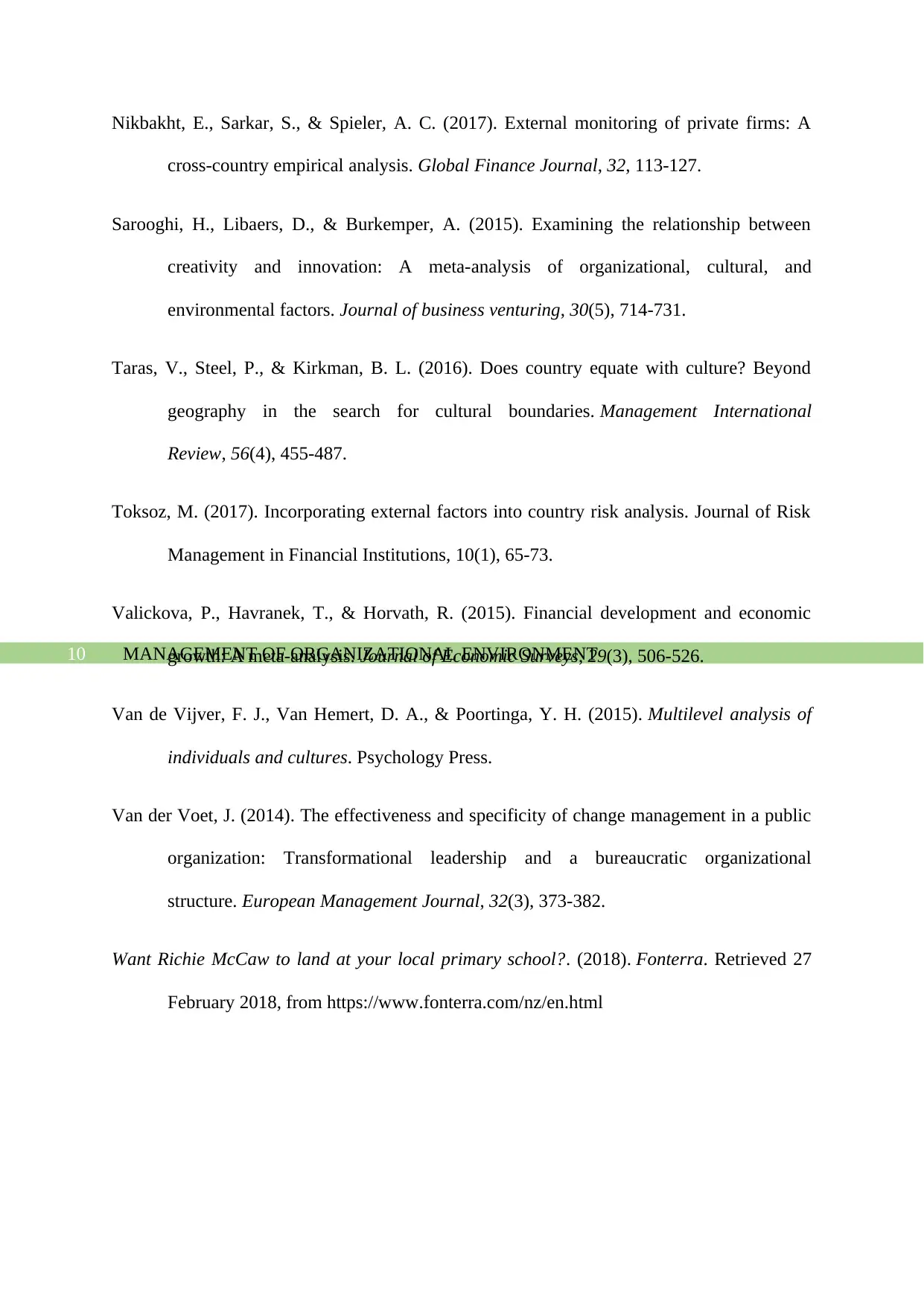
MANAGEMENT OF ORGANIZATIONAL ENVIRONMENT10
Nikbakht, E., Sarkar, S., & Spieler, A. C. (2017). External monitoring of private firms: A
cross-country empirical analysis. Global Finance Journal, 32, 113-127.
Sarooghi, H., Libaers, D., & Burkemper, A. (2015). Examining the relationship between
creativity and innovation: A meta-analysis of organizational, cultural, and
environmental factors. Journal of business venturing, 30(5), 714-731.
Taras, V., Steel, P., & Kirkman, B. L. (2016). Does country equate with culture? Beyond
geography in the search for cultural boundaries. Management International
Review, 56(4), 455-487.
Toksoz, M. (2017). Incorporating external factors into country risk analysis. Journal of Risk
Management in Financial Institutions, 10(1), 65-73.
Valickova, P., Havranek, T., & Horvath, R. (2015). Financial development and economic
growth: A meta‐analysis. Journal of Economic Surveys, 29(3), 506-526.
Van de Vijver, F. J., Van Hemert, D. A., & Poortinga, Y. H. (2015). Multilevel analysis of
individuals and cultures. Psychology Press.
Van der Voet, J. (2014). The effectiveness and specificity of change management in a public
organization: Transformational leadership and a bureaucratic organizational
structure. European Management Journal, 32(3), 373-382.
Want Richie McCaw to land at your local primary school?. (2018). Fonterra. Retrieved 27
February 2018, from https://www.fonterra.com/nz/en.html
Nikbakht, E., Sarkar, S., & Spieler, A. C. (2017). External monitoring of private firms: A
cross-country empirical analysis. Global Finance Journal, 32, 113-127.
Sarooghi, H., Libaers, D., & Burkemper, A. (2015). Examining the relationship between
creativity and innovation: A meta-analysis of organizational, cultural, and
environmental factors. Journal of business venturing, 30(5), 714-731.
Taras, V., Steel, P., & Kirkman, B. L. (2016). Does country equate with culture? Beyond
geography in the search for cultural boundaries. Management International
Review, 56(4), 455-487.
Toksoz, M. (2017). Incorporating external factors into country risk analysis. Journal of Risk
Management in Financial Institutions, 10(1), 65-73.
Valickova, P., Havranek, T., & Horvath, R. (2015). Financial development and economic
growth: A meta‐analysis. Journal of Economic Surveys, 29(3), 506-526.
Van de Vijver, F. J., Van Hemert, D. A., & Poortinga, Y. H. (2015). Multilevel analysis of
individuals and cultures. Psychology Press.
Van der Voet, J. (2014). The effectiveness and specificity of change management in a public
organization: Transformational leadership and a bureaucratic organizational
structure. European Management Journal, 32(3), 373-382.
Want Richie McCaw to land at your local primary school?. (2018). Fonterra. Retrieved 27
February 2018, from https://www.fonterra.com/nz/en.html
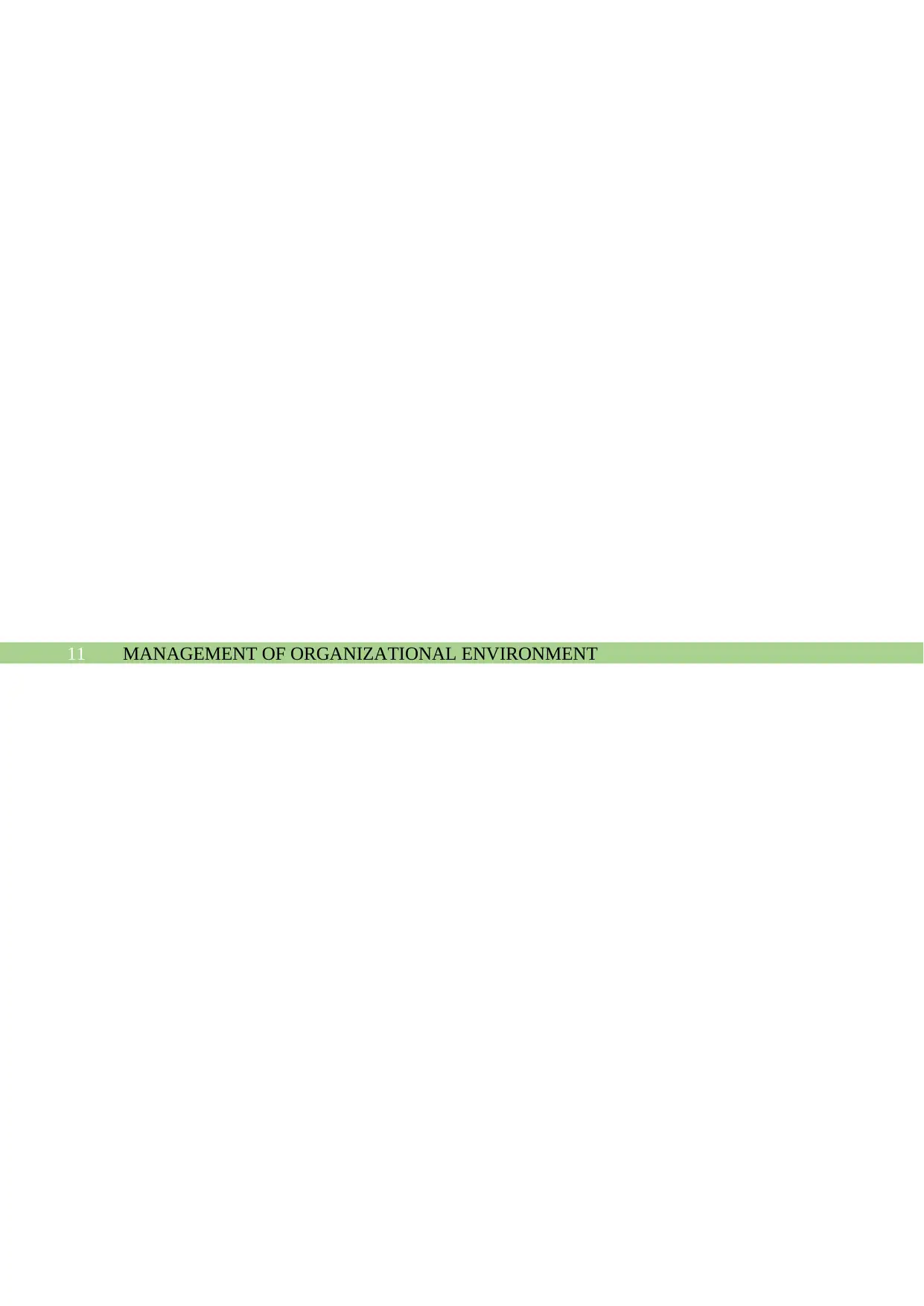
MANAGEMENT OF ORGANIZATIONAL ENVIRONMENT11
⊘ This is a preview!⊘
Do you want full access?
Subscribe today to unlock all pages.

Trusted by 1+ million students worldwide
1 out of 12
Related Documents
Your All-in-One AI-Powered Toolkit for Academic Success.
+13062052269
info@desklib.com
Available 24*7 on WhatsApp / Email
![[object Object]](/_next/static/media/star-bottom.7253800d.svg)
Unlock your academic potential
Copyright © 2020–2025 A2Z Services. All Rights Reserved. Developed and managed by ZUCOL.





